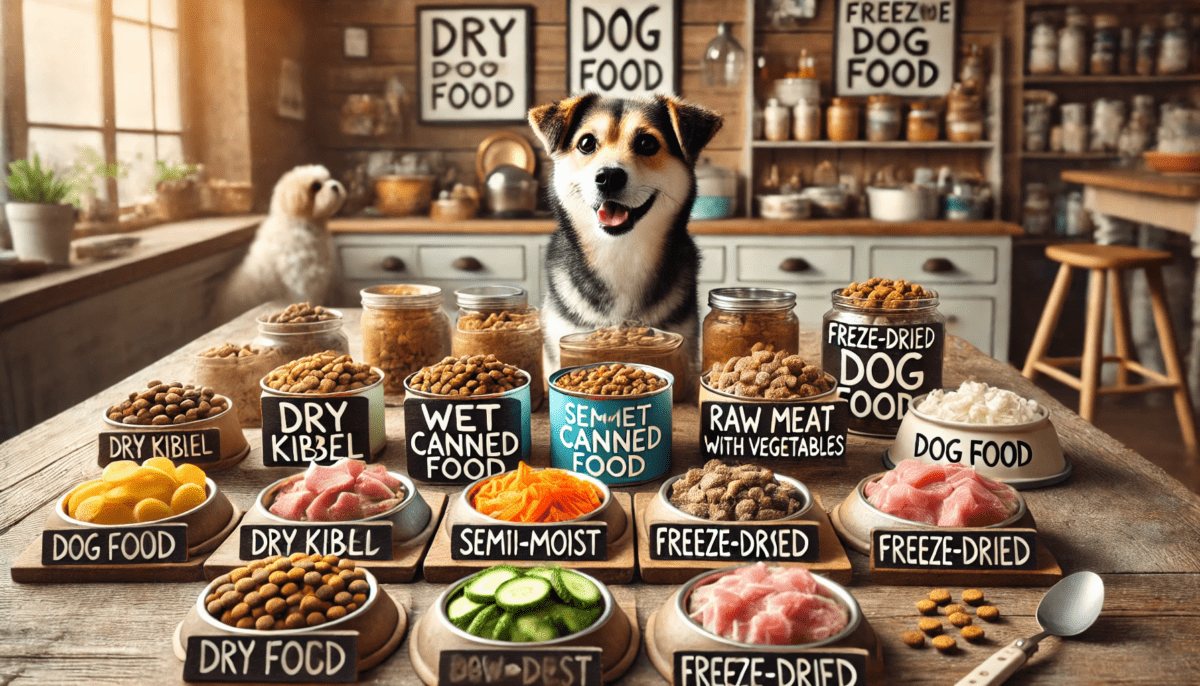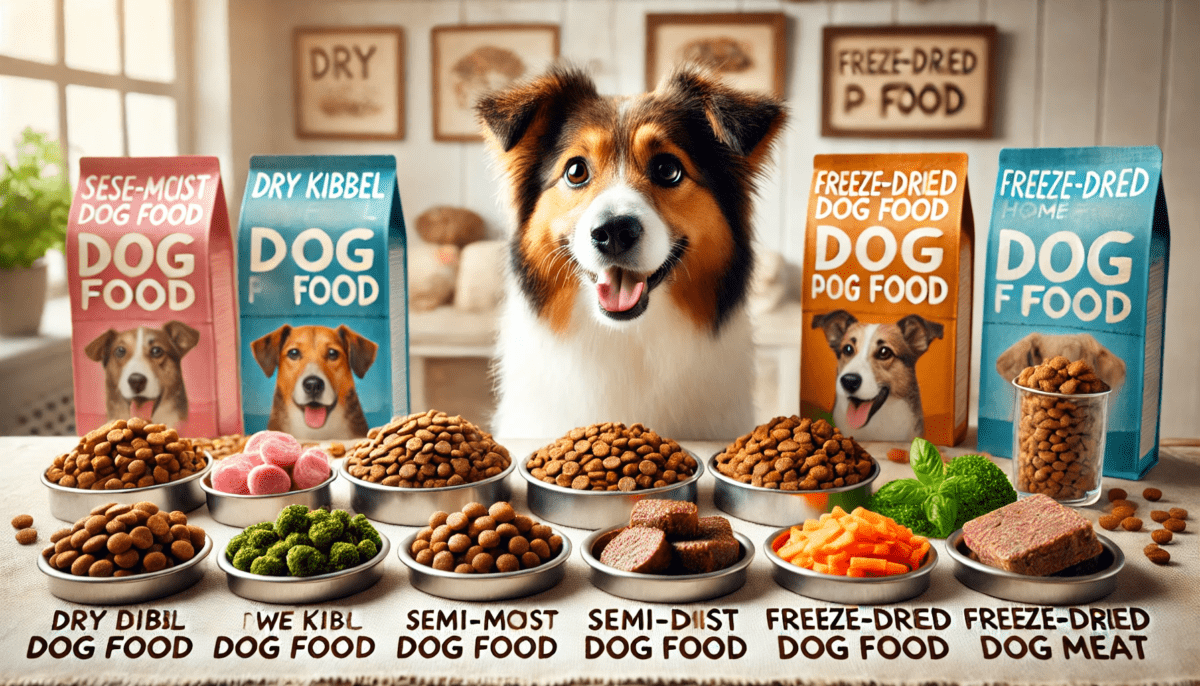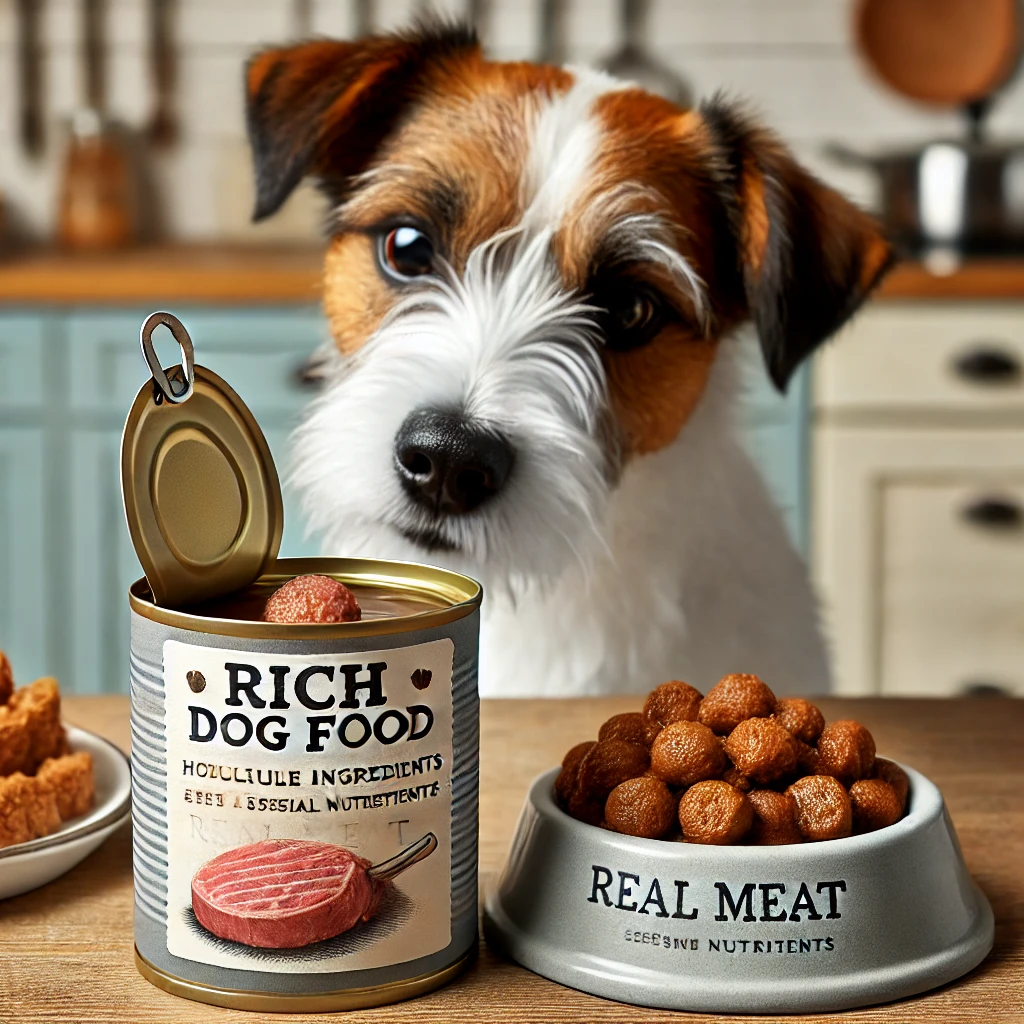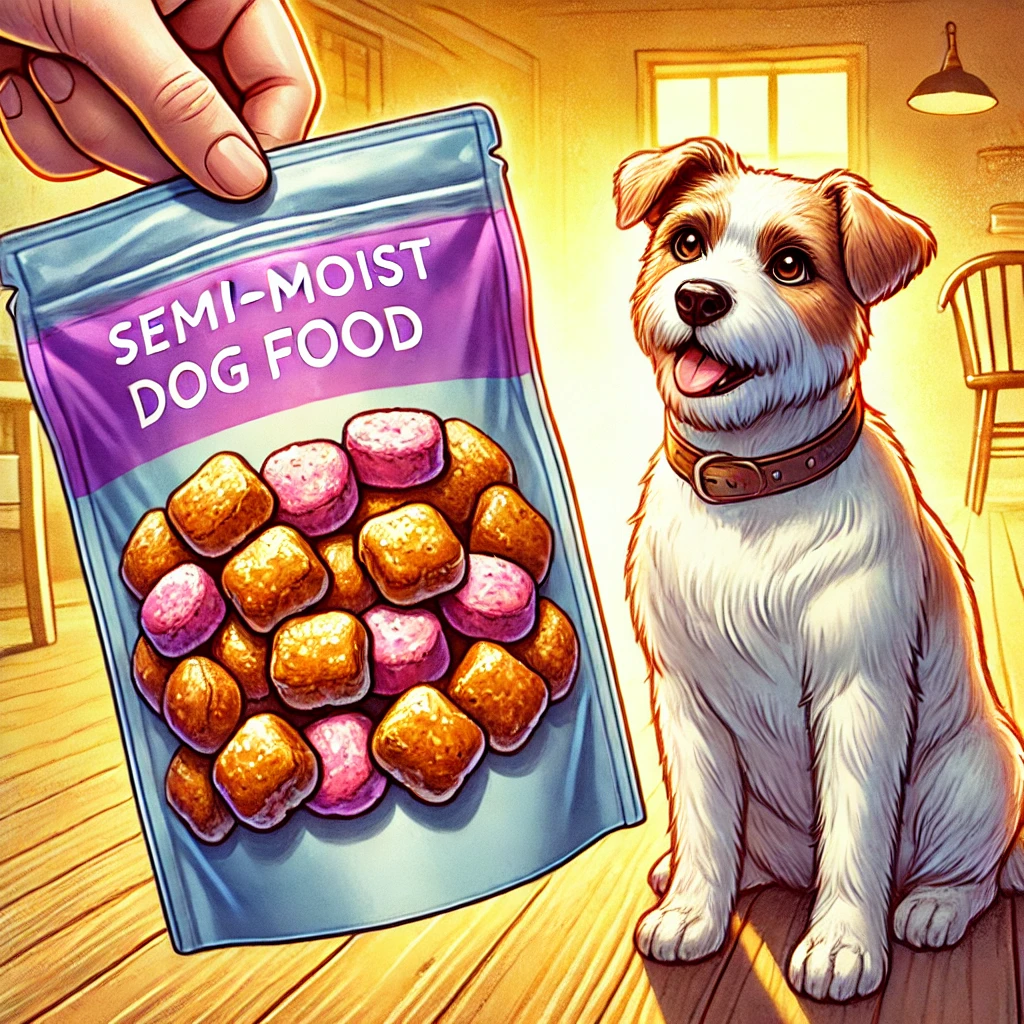
Types of Dog Food
| Type of Dog Food | Description | Advantages | Drawbacks |
|---|---|---|---|
| Dry Dog Food (Kibble) | Crunchy, dry pellets made from meat, grains, and vegetables. Easy to store and feed. | Convenient, affordable, long shelf-life, helps with dental hygiene | Can contain fillers or artificial ingredients, some dogs may find it less appetizing |
| Wet Dog Food (Canned) | Soft, high-moisture food, usually made from real meat or meat by-products. Comes in cans. | Tasty, high in protein, good for dogs with dental issues or who need more hydration | Shorter shelf-life once opened, often more expensive, can be high in fat |
| Semi-Moist Dog Food | Soft, chewy food typically found in pouches, with a texture between dry and wet food. | Flavorful, easy to chew, good for picky eaters or dogs with chewing difficulties | Often contains artificial flavors, colors, and high levels of sugar or salt; lower nutritional value |
| Raw Dog Food | Uncooked meat, bones, and sometimes vegetables. Mimics a dog’s natural diet. | Natural ingredients, high in nutrients, promotes healthy coats and energy | Requires careful handling to avoid bacteria, can be expensive, difficult to balance nutrients, needs vet guidance |
| Homemade Dog Food | Meals prepared at home with fresh ingredients like lean meat, vegetables, and grains. | Full control over ingredients, customizable for dogs with allergies or dietary needs | Requires time and effort, challenging to ensure balanced nutrition, needs vet or nutritionist guidance |
| Freeze-Dried and Dehydrated Dog Food | Raw or cooked food that has been freeze-dried or dehydrated to remove moisture; rehydrated with water before feeding. | High-quality ingredients, convenient storage, nutritious, good for traveling or hiking | Expensive, requires careful rehydration, feeding dry can cause digestive issues |
| Prescription Dog Food | Specially formulated diet for dogs with specific health conditions, available through vets. | Targeted nutrition for health issues, helps manage conditions, improves quality of life | Only available through a vet, often more expensive |

Hello, friends! Today, I’m diving into a topic that every dog lover should know about: “Types of Dog Food!” Picking the right food for our furry friends is super important because, just like us, dogs need a balanced diet to stay healthy, happy, and full of energy. Let’s explore the different kinds of dog food out there, so you can make the best choice for your best buddy!
1. Dry Dog Food (Kibble)

Dry dog food, often called kibble, is one of the most popular types of dog food out there. Why? It’s convenient, affordable, and easy to store. Kibble usually comes in big bags, and it doesn’t spoil easily, which makes it super convenient for busy pet parents. But there’s more to it than just convenience!
Most dry dog food is made by mixing together meat, grains, and other ingredients and then baking or cooking them at high temperatures. This process removes moisture, leaving behind those crunchy little bites that dogs love! Many kibble brands are designed to provide complete nutrition, which means they contain all the protein, vitamins, and minerals a dog needs. Plus, the crunchy texture can help clean your dog’s teeth by scraping away plaque!
However, not all kibble is created equal. Some brands are packed with fillers and artificial ingredients that don’t offer much nutritional value. That’s why it’s super important to check the label and pick a high-quality brand. Look for ingredients like real meat, whole grains, and vegetables – things that are easy to recognize!
2. Wet Dog Food (Canned)

Canned dog food, or wet dog food, is another popular choice. It’s known for being extra tasty and is often more appealing to picky eaters or dogs who just don’t like dry food. Wet dog food comes in cans, and it has a higher moisture content than kibble, which can be a big plus for dogs who don’t drink enough water.
One of the main benefits of wet dog food is its high protein content. Many wet dog foods are made with real meat or meat by-products, which means they’re packed with flavor and nutrients. The soft texture can be easier on the teeth and stomach, especially for older dogs or puppies who have trouble chewing hard kibble.
But, as with kibble, there are different quality levels in wet food. Some canned foods can contain a lot of fat, fillers, or preservatives, which aren’t great for your dog’s health. Always check the ingredients and try to go for high-quality brands that use real, wholesome ingredients.
3. Semi-Moist Dog Food

Semi-moist dog food is somewhere between dry and wet food. It usually comes in pouches and has a soft, chewy texture. This type of food can be convenient and is often appealing to dogs because it’s flavorful and moist. Semi-moist dog food used to be more popular, but it’s not as common today because it often contains a lot of artificial flavors, colors, and preservatives.
Semi-moist food can be good for dogs who are picky or have difficulty eating hard kibble. However, it’s usually not the healthiest option. Many semi-moist foods are high in sugar and salt, which makes them taste good but isn’t ideal for a dog’s health. It’s generally recommended to use semi-moist food as an occasional treat or mixer with other types of food, rather than as a main meal.
4. Raw Dog Food

Raw dog food, sometimes called the “BARF” diet (Biologically Appropriate Raw Food), is all about feeding your dog uncooked meat, bones, and sometimes fruits and vegetables. This type of diet is based on what dogs would eat in the wild, and some people believe it’s more natural and healthier for their pets.
A raw diet can include things like raw meat, raw organs, raw eggs, and certain vegetables. The idea is that cooking can destroy some of the nutrients in food, so feeding raw keeps all those nutrients intact. Many dogs on raw diets have shiny coats, healthy teeth, and lots of energy!
However, raw feeding can be a bit tricky. It takes careful planning to make sure your dog is getting all the nutrients they need. There’s also the risk of bacteria in raw meat, which can be dangerous for both you and your dog if not handled properly. It’s best to do plenty of research and talk to a vet before starting a raw diet for your dog.
5. Homemade Dog Food

Homemade dog food is exactly what it sounds like: food you make at home for your dog. This can be a great option for pet owners who want full control over what their dog eats. With homemade food, you know exactly what ingredients are going into each meal, which is awesome for dogs with allergies or specific dietary needs.
Making dog food at home means you can use fresh, high-quality ingredients, like lean meats, vegetables, and grains. But it also takes time and effort to make sure each meal is balanced. Dogs need the right mix of proteins, fats, carbs, and essential nutrients like vitamins and minerals, so it’s not as simple as just giving them leftovers from dinner.
If you’re considering homemade food, it’s a good idea to work with a vet or a pet nutritionist to create recipes that meet all of your dog’s nutritional needs. Homemade dog food can be incredibly rewarding but needs careful planning to ensure it’s complete and balanced.
6. Freeze-Dried and Dehydrated Dog Food

Freeze-dried and dehydrated dog food are unique options that are becoming more popular. These types of food are made by removing moisture from fresh ingredients, either through freezing or drying. When you’re ready to feed your dog, you just add water to rehydrate the food, and voila – a fresh meal is ready to go!
Freeze-dried and dehydrated foods often contain high-quality ingredients, like real meat, vegetables, and even fruits. They can be a great option for people who want the benefits of raw food without the hassle of handling raw meat. These foods are also super convenient because they’re lightweight and easy to store – perfect for travel or hiking!
The main downside is that freeze-dried and dehydrated foods can be pretty pricey. However, the quality is usually worth the extra cost. Just make sure to follow the instructions for rehydrating, as feeding it dry could cause digestive issues.
7. Prescription Dog Food

Prescription dog food is specially formulated for dogs with specific health issues. These foods are often recommended by veterinarians for dogs with conditions like kidney disease, allergies, obesity, or digestive problems. Prescription diets are designed to provide the right balance of nutrients for dogs who need a little extra care.
For example, a dog with kidney disease might need a diet that’s low in protein and phosphorus, while a dog with allergies may benefit from a limited-ingredient or hypoallergenic formula. Prescription dog food can be a game-changer for dogs with medical needs, helping to manage symptoms and improve their quality of life.
However, prescription food can be quite expensive, and it’s only available through a vet. If your dog has a medical condition, talk to your vet about whether a prescription diet might be a good fit. It could make a huge difference in their overall well-being!
How to Choose the Right Type of Dog Food for Your Dog
Now that we’ve explored the different types of dog food, you might be wondering, “How do I pick the best one for my dog?” Great question! The answer depends on your dog’s age, size, health, activity level, and even their personal taste. Here are some quick tips to help you choose:
- Consider Your Dog’s Age and Health – Puppies, adults, and senior dogs have different nutritional needs. Likewise, a healthy dog will have different needs compared to a dog with a health condition.
- Think About Your Lifestyle – If you’re super busy, kibble or freeze-dried food might be the easiest option. But if you have the time, homemade or raw food could offer more control over what your dog eats.
- Check the Ingredients – Always look for high-quality ingredients like real meat, whole grains, and vegetables. Avoid foods with too many fillers, artificial colors, or flavors.
- Ask Your Vet for Advice – Your vet knows your dog’s health best and can offer personalized advice on what type of food might be right for them.
- Watch How Your Dog Reacts – After choosing a type of food, pay attention to how your dog feels. If they seem energetic, have a shiny coat, and healthy stools, you’re on the right track!
Finding the Perfect Food for Your Dog
Choosing the right type of dog food can be a bit overwhelming with all the options out there, but remember, it’s all about finding what works best for your dog’s unique needs. Whether it’s dry kibble, tasty canned food, or a raw diet, each type of food has its own perks. Just keep an eye on your dog’s health, try a few options if needed, and most importantly, enjoy every meal with your furry friend. After all, they’re not just pets – they’re family!
FAQ: Choosing the Perfect Dog Food for Your Furry Friend
What is the best type of dog food for my dog’s health and happiness?
Choosing the best dog food depends on your dog’s unique needs, age, and lifestyle. Dry dog food, or kibble, is great for convenience and dental health, while wet food offers moisture and can be more flavorful for picky eaters. Raw and homemade options give you full control over ingredients, ensuring maximum freshness and quality. However, each type has pros and cons, so think about your dog’s specific needs. Consulting with your vet can guide you to a choice that will keep your pup happy, healthy, and full of energy!
How do I know if dry dog food (kibble) is right for my dog?
Dry dog food is a fantastic option if you’re looking for convenience, affordability, and longer storage life. Kibble is not only easy to handle but also helps in maintaining your dog’s dental health. Plus, high-quality kibble options are packed with essential nutrients, so your dog gets a balanced meal in every bite! It’s a wonderful choice for busy pet parents, but remember to check the ingredient list. Look for kibble with real meat, whole grains, and vegetables – ingredients that support vitality and well-being without unnecessary fillers.
Is wet dog food better for hydration and taste?
Yes! Wet dog food, often called canned food, is an excellent choice for dogs who might need extra moisture in their diet or those who are picky eaters. Wet food typically has a higher protein content and a rich flavor, making it super appealing for dogs. This option is especially beneficial for older dogs who might struggle with dry kibble. The high water content also aids hydration, which is a big plus. However, wet food can be more expensive and has a shorter shelf life once opened. As always, check the ingredients to ensure it’s packed with nutritious, high-quality ingredients!
What are the benefits of a raw food diet for dogs?
A raw food diet, often called the “BARF” diet (Biologically Appropriate Raw Food), can provide incredible benefits for some dogs. It offers a natural and fresh approach to feeding, focusing on raw meats, bones, and veggies, which are nutrient-dense. Many owners notice that dogs on raw diets have shinier coats, healthier teeth, and improved energy levels. However, this diet does require a bit more effort and knowledge to make sure your pup is getting everything they need. Talking to a vet or pet nutritionist before starting a raw diet can ensure it’s safe, balanced, and tailored to your dog’s needs!
Is homemade dog food a healthy option for my pet?
Absolutely! Homemade dog food allows you to have full control over your pet’s meals, which means you can use fresh, high-quality ingredients like lean meats, vegetables, and grains. This is perfect for dogs with specific dietary needs or allergies. Plus, there’s a special joy in preparing meals for your beloved pet! However, homemade dog food requires careful planning to ensure your dog receives all essential nutrients. Partnering with a vet or pet nutritionist can help you create recipes that are balanced and health-boosting, giving your furry friend all the nutrients they need to thrive.
What makes freeze-dried and dehydrated dog food different?
Freeze-dried and dehydrated dog foods are innovative and convenient options that retain the nutritional benefits of raw or fresh foods. These foods are made by removing moisture from fresh ingredients, allowing for a lightweight, shelf-stable option that only needs water added before serving. Freeze-dried and dehydrated foods often contain real meat and vegetables, providing top-notch quality and flavor. They’re ideal for travel or pet parents looking for a less messy raw diet alternative. While they can be more expensive, the quality and convenience make them a valuable choice for pet owners who want nutritious and simple feeding solutions.
Why might my dog need prescription dog food?
Prescription dog food is specially formulated to address specific health issues, making it a valuable option for dogs with unique needs. If your dog has a medical condition, such as kidney disease, allergies, or digestive problems, a prescription diet can help manage symptoms and improve their overall quality of life. These foods are designed with the right balance of nutrients to support their health while being gentle on sensitive systems. Although prescription diets are available only through a vet and can be pricier, they’re a worthwhile investment for maintaining your pet’s health and happiness.
How can I pick the perfect dog food for my furry friend?
Choosing the ideal food for your dog is a loving decision that should consider their age, size, health, and lifestyle. Start by assessing their needs: puppies, adult dogs, and seniors have different requirements, as do dogs with health issues. Always look for foods with real, wholesome ingredients and avoid artificial fillers. Your vet can provide personalized advice to guide you toward the best choice. And don’t forget to watch how your dog reacts to their food – shiny coats, healthy energy levels, and a happy tail wagging mean you’re on the right track!

Author Bio:
Jake Thompson is a passionate pet lover and freelance writer specializing in pet care, nutrition, and animal wellness. With years of experience in researching and reviewing pet products, Jake is dedicated to helping pet parents make informed choices for their furry friends. When he’s not writing, you can find him hiking with his Labrador, Max, or testing out new dog treats in the kitchen. Jake’s honest reviews and pet tips aim to bring happy tails and healthier lives to pets everywhere.